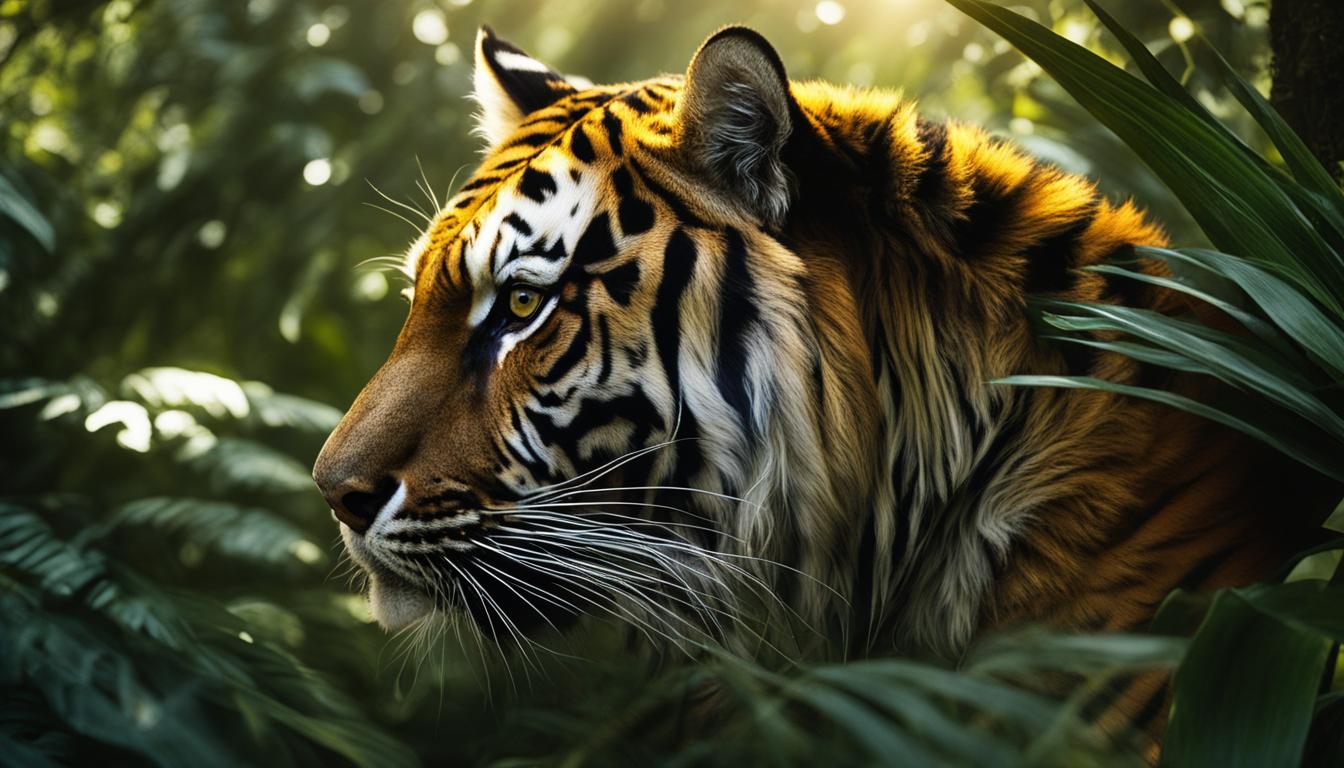Tigers are fascinating creatures, known for their majestic presence and striking appearance. One of the most distinctive features of tigers is their beautiful striped coats. These stripes serve a crucial purpose in the tiger’s natural habitat.
The primary function of the tiger’s stripes is camouflage. The unique patterns help the tiger blend seamlessly into its surroundings, making it difficult for prey to spot them. This natural form of concealment enhances the tiger’s hunting success, allowing them to approach their prey undetected.
Not only do the tiger’s stripes provide them with essential camouflage, but they also add to their overall aesthetic charm. The feline markings on their coats have inspired trendy fashion designs, like the popular tiger print, which is often seen in clothing and accessories. Nature-inspired designs that incorporate tiger stripes bring a touch of the wild to our modern world.
Key Takeaways:
- Tiger stripes serve the purpose of camouflage in their natural habitat.
- The unique patterns help tigers blend into their surroundings, making it difficult for prey to spot them.
- Tiger stripes have inspired fashionable designs like the popular tiger print.
- These nature-inspired designs bring a touch of the wild into the fashion industry.
- Tigers are fascinating creatures with a variety of distinctive features.
Camouflage and Disruptive Coloration
The distinctive stripes seen on a tiger’s coat serve a vital purpose in camouflage, employing a concept known as disruptive coloration. This remarkable adaptation allows tigers to blend seamlessly into their natural habitats, enabling them to stalk and ambush their prey undetected.
Through the use of vertical stripes, a tiger’s shape and size are broken up, creating a visual disruption that confuses the eyes of potential threats and prey. In dense forests or tall grasses, the tiger’s stripes blend with the vertical patterns of the surrounding vegetation, rendering it nearly invisible.
This strategy of disruptive coloration provides tigers with a significant advantage in their stealthy hunting endeavors. By remaining hidden until the perfect moment, tigers can swiftly and silently approach their prey, giving them a higher chance of success.
Camouflage and Disruptive Coloration in Action
| Scenario | Advantage of Tiger’s Camouflage |
|---|---|
| Tiger stalking in tall grass | Blends with the vertical patterns of the grass, making it difficult for prey to detect. |
| Tiger moving through a forest | Camouflages with the vertical tree trunks, making it hard for predators or prey to spot. |
| Tiger hiding in the shadows | Utilizes the contrasting light and dark stripes to blend into the dappled light of the forest, remaining hidden. |
Tiger stripes are nature’s clever way of giving these magnificent predators the upper hand in their hunting pursuits. By embracing the power of disruptive coloration, tigers have perfected the art of blending in while remaining extraordinary.
This fascinating adaptation is not only aesthetically captivating but also plays a critical role in the survival of tigers in the wild. It highlights the incredible beauty and ingenuity of nature’s designs, reminding us of the remarkable world we share with these incredible creatures.
Importance of Stripes for Hunting
Tigers are agile and stealthy solitary predators that rely on their hunting skills for survival. Their distinctive striped coats serve a crucial role in their hunting strategy by enhancing their ability to remain undetected in their natural habitat.
These stripes, consisting of dark and light fur patterns, allow tigers to blend seamlessly with their surroundings, making it easier for them to stalk their prey unnoticed. The vertical stripes help break up the tiger’s silhouette, camouflaging them among the dense vegetation, such as trees and tall grasses, in their habitat.
By utilizing their stripes to their advantage, tigers can approach their prey silently and get as close as possible without being detected. This stealth approach significantly increases their chances of a successful hunt, as their unsuspecting prey remains unaware of their presence until it’s too late.
<!–Hunting Techniques
Tigers employ a range of hunting techniques to secure their meal. These techniques include ambushing – where the tiger patiently waits in camouflage until the prey is within striking distance, and stalking – where the tiger stealthily follows their prey until they are close enough to pounce. These techniques, combined with their extraordinary athleticism and powerful jaws, make tigers apex predators in their respective ecosystems.
–> <!–| Tiger Species | Stripes Pattern |
|---|---|
| Bengal Tiger | Dark black stripes on a light orange-brown base |
| Siberian Tiger | Wide, spaced-out stripes on a pale orange coat |
| Sumatran Tiger | Narrower stripes on a darker, reddish-orange coat |
“The stripes on a tiger’s coat are like a secret weapon, allowing them to blend into their environment and become invisible until it’s too late for their prey.” – Wildlife expert–> <!–
In addition to aiding in hunting, the stripes on a tiger’s coat also play a role in communication and identification within their species. Each tiger has a unique stripe pattern, similar to human fingerprints, allowing for easy identification. The stripes also play a part in courtship rituals and helping cubs stay close to their mothers in the wild.
–> <!–- Hunting techniques employed by tigers
- How stripes contribute to successful hunting
- Communication and identification through stripe patterns
Overall, the stripes on a tiger’s coat are not just a beautiful and distinctive feature, but an integral part of their hunting prowess as solitary predators. By blending into their surroundings and employing stealthy hunting techniques, tigers can effectively secure their next meal and maintain their position as apex predators in their ecosystems.
Variation in Tiger Stripes
Tigers are known for their iconic stripes, but did you know that these stripes can vary among different tiger subspecies? Each subspecies has its own unique patterns and characteristics that make it distinct. For example, the Sumatran tiger, found on the Indonesian island of Sumatra, has narrower stripes compared to other subspecies. This variation in stripe width and pattern is influenced by factors such as habitat and genetics.
Not only do the stripes vary in width and pattern, but each tiger’s stripe pattern is also unique, similar to human fingerprints. These distinctive patterns help researchers identify individual tigers in the wild. By studying the variations in tiger stripes, scientists can gain insights into population dynamics, behavior, and genetic diversity. It is truly fascinating how such a simple characteristic as a stripe pattern can hold so much information.
Variations in Tiger Subspecies
Let’s take a closer look at the different subspecies of tigers and their unique stripe characteristics:
| Tiger Subspecies | Stripe Pattern | Stripe Width | Habitat |
|---|---|---|---|
| Bengal Tiger | Wide, bold stripes | Varying widths | Forest and grassland |
| Siberian Tiger | Thicker, spaced-out stripes | Broader stripes | Taiga, forest, and grassland |
| Sumatran Tiger | Narrow, close-set stripes | Narrower stripes | Island rainforest |
| Indochinese Tiger | Dark, narrow stripes | Medium-width stripes | Forest and grassland |
| Malayan Tiger | Close-set, vertical stripes | Varied stripe widths | Forest and mangrove swamps |
| Amur Tiger | Distinctive, bold stripes | Wide, closely spaced stripes | Taiga and forest |
As you can see, each subspecies has its own unique characteristics that set it apart. The variations in stripe width, pattern, and coloration are adaptations to their specific habitats, allowing them to better blend in and survive in their respective environments. It’s truly remarkable how nature has equipped each subspecies of tiger with its own distinctive appearance.
Other Animals with Stripes
While tigers are known for their distinctive stripes, they are certainly not the only animals that use patterns for camouflage. Let’s take a closer look at some other fascinating creatures with stripes:
Bongos:
Bongos are large antelopes found in the dense forests of Central and West Africa. These beautiful animals have striking vertical stripes on their coats. The stripes help bongos blend into the shadows and dappled light of the forest, making it difficult for predators to spot them. The intricate pattern of their stripes is nature’s way of providing them with effective camouflage in their habitat.
Okapis:
Okapis are unique animals that have a similar body shape to a giraffe but with the stripes of a zebra. These elusive creatures are found in the dense rainforests of the Democratic Republic of Congo. The stripes on their hindquarters blend in with the dappled sunlight that filters through the forest canopy, making them nearly invisible in their natural environment. The camouflage provided by their stripes helps okapis stay hidden from predators and facilitates their successful foraging.
Zebra Stripes:
Zebras are perhaps the most iconic animals with stripes. Their bold black and white stripes are not only visually striking but also serve as effective camouflage. The stripes create an optical illusion, confusing predators and making it difficult for them to single out an individual zebra in a group. Additionally, scientists have discovered that the stripes repel horseflies and tsetse flies, which are known to carry diseases. The striped pattern disrupts the flies’ ability to land on the zebras, providing the animals with both camouflage and protection.
| Animal | Camouflage Strategy |
|---|---|
| Bongos | Vertical stripes blend with forest shadows and light. |
| Okapis | Stripes blend with dappled sunlight in rainforest canopies. |
| Zebras | Stripes create visual confusion and repel flies. |
These animals demonstrate the power of stripes as an effective form of camouflage in the animal kingdom. From the dense forests of Africa to the open savannahs, stripes provide a survival advantage, whether it be for blending into the shadows, dappled light, or confusing predators. The diversity of patterns and strategies among these animals showcases the ingenuity of nature and its ability to adapt and thrive in different habitats.
White Tigers and Genetic Mutations
White tigers are a captivating variation of their orange-furred counterparts. These majestic creatures possess a rare genetic mutation that results in their distinctive white fur. While they may stand out in their natural habitat, white tigers are not as common as orange tigers. It is important to note that the white fur does not provide the same level of camouflage as the orange fur, making white tigers more vulnerable in the wild.
The unique genetic mutation responsible for white fur is a result of inbreeding in captivity. This practice has been adopted to create these mesmerizing animals for the purpose of attracting visitors. However, it is crucial to consider the potential negative consequences of inbreeding, as it can lead to detrimental health issues and reduced genetic diversity among the tiger population.
In the wild, tigers rely on their distinctive stripes for camouflage, allowing them to blend seamlessly into their surroundings. The orange fur with dark stripes provides effective concealment, enhancing their hunting prowess. The white fur of these genetic mutations fails to offer the same advantage, making it more difficult for white tigers to camouflage themselves during hunting expeditions.
“White tigers, although visually striking, are not well-suited for survival in the wild due to their lack of effective camouflage. The popularity of these rare creatures raises concerns about the ethical treatment and conservation of tigers.” – Wildlife Conservationist
| Characteristics | Orange Tigers | White Tigers |
|---|---|---|
| Fur Color | Orange with dark stripes | Pure white with faint stripes |
| Camouflage | Excellent camouflage for hunting | Poor camouflage, making them more visible |
| Genetic Diversity | Higher genetic diversity among the population | Reduced genetic diversity due to inbreeding |
| Habitat | Varying habitats across tiger range countries | Found in captivity, mainly as a result of selective breeding |
White tigers, despite their visual allure, should be seen as a reminder of the importance of responsible breeding practices and conservation efforts. These magnificent creatures deserve our protection, and it is crucial to focus on preserving the natural behavior and habitats of wild tigers to ensure the survival of this iconic species.
Tiger Conservation and Ecotourism
Tigers are an endangered species, and their conservation is of utmost importance. The rapid decline in tiger populations is primarily due to illegal poaching for their valuable pelts and body parts. To protect these majestic creatures and their habitats, conservation efforts and ecotourism initiatives have become crucial.
Conservation organizations around the world are working tirelessly to implement strategies that safeguard tigers from poaching and habitat destruction. These efforts include establishing protected areas, implementing anti-poaching measures, and promoting sustainable land-use practices. By supporting these conservation initiatives, we can contribute to the preservation of tiger populations for future generations.
Ecotourism: A Sustainable Solution
Ecotourism, which focuses on responsible travel to natural areas, has emerged as a promising solution for tiger conservation. By engaging in eco-friendly tourism practices, visitors can experience the beauty of tigers in their natural habitats while supporting local communities and wildlife conservation.
Responsible ecotourism provides economic incentives for local communities to protect tiger habitats and actively participate in conservation efforts. Funds generated from ecotourism activities are often invested in anti-poaching measures, habitat restoration, and community education programs. By choosing eco-friendly tour operators and participating in guided tours, you can help protect tigers and contribute towards their long-term survival.
Protection of an Endangered Species
Tigers are not only an iconic symbol of wilderness but also play a vital role in maintaining ecosystem balance. As apex predators, they regulate prey populations, ensuring the health and vitality of the habitats they inhabit. Their conservation is necessary not only for their own survival but also for the preservation of biodiversity and the overall well-being of our planet.
By supporting tiger conservation and ecotourism, we can help protect these magnificent animals from extinction. Together, we can ensure that future generations have the opportunity to witness the beauty and power of tigers in the wild.
| Benefits of Tiger Conservation and Ecotourism | Actions to Support Tiger Conservation |
|---|---|
|
|
Conclusion
Tiger stripes serve a crucial purpose in the wild, allowing these magnificent creatures to blend seamlessly into their natural surroundings. The purpose of these distinctive patterns is camouflage, aiding tigers in their stealthy hunting endeavors. The stripes break up the tiger’s shape and size, making it challenging for prey to detect their presence.
However, the unique beauty of tiger stripes also makes these majestic animals targets for illegal poaching, posing a significant threat to their survival in the wild. Conservation efforts and responsible ecotourism play a vital role in protecting tigers and preserving their natural habitats. By supporting these initiatives, you can contribute to the long-term conservation of these incredible creatures.
Remember, the preservation of tiger populations is essential not only for their own sake but also for the health of their ecosystems. Tigers are apex predators, playing a crucial role in maintaining ecological balance. As we strive to protect these magnificent animals and their habitats, we ensure the survival of not just tigers, but also the countless other species that rely on healthy ecosystems.
What is the Purpose of a Lion’s Mane, and How does it Compare to the Purpose of a Tiger’s Stripes?
The purpose of male lion manes is multifaceted. Firstly, they serve as a symbol of dominance and masculinity, intimidating rival males. Additionally, they protect vital organs during fights. On the other hand, tiger stripes primarily aid in camouflage, allowing them to blend seamlessly into their surroundings. While both adaptations have distinct purposes, they highlight the unique strategies employed by lions and tigers for survival.
FAQ
What is the purpose of tiger stripes?
Tiger stripes serve as camouflage, allowing tigers to blend into their surroundings while hunting.
How do tiger stripes help with camouflage?
The vertical stripes on a tiger’s coat help break up its shape and size, making it difficult to detect by prey.
Do all tiger subspecies have the same stripe pattern?
No, the stripes on tigers can vary among the six different subspecies, with variations in width and number of stripes.
Do other animals use stripes for camouflage?
Yes, animals like bongos, okapis, and zebras also use stripes to blend into their habitats.
Are white tigers as camouflaged as orange tigers?
No, white tigers are not as camouflaged as their orange counterparts and are more vulnerable in the wild.
How can I contribute to tiger conservation?
Supporting conservation efforts and responsible ecotourism practices can help protect tigers and their habitats.






